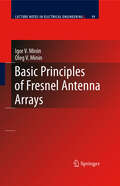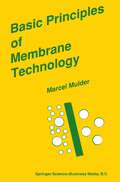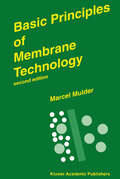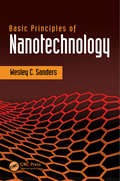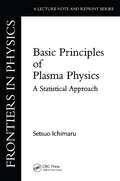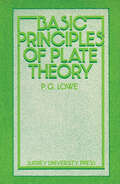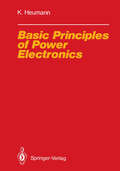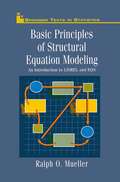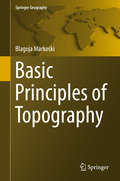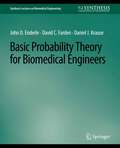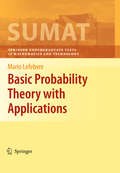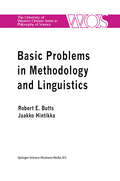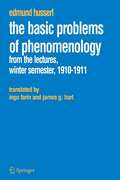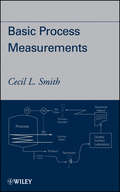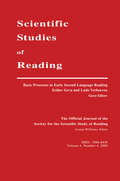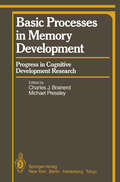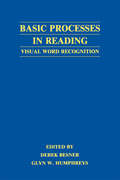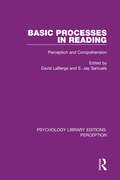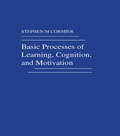- Table View
- List View
Basic Principles of Fresnel Antenna Arrays (Lecture Notes in Electrical Engineering #19)
by Igor V. Minin Oleg V. MininAntennas represent a critical technology in any of these wireless systems. Not only do they directly affect the received power of the system, they are also typically the largest and most visible part. Recently, the need for low-cost, low-profile, and lightweight antenna in the frequency range of the microwave/millimeter wave/THz band has regained momentum. "Basic Principles of Fresnel Antenna Arrays" provides us a with the basics of the various Fresnel Antenna approaches, in order to achieve low-cost, low-profile, and lightweight antenna in the microwave/millimeter wave band. A potential solution of the antenna problem lies in using lens technology in an array. The Fresnel zone plate lens (FZPL) antenna is in particular an interesting candidate for the array element. The limiting focusing properties of FZPL including subwave length focus are described in detail. The book further presents a novel hexagonal FZPL antenna which can be more effectively packed in an array due to its shape. Before considering the hexagonal FZPL antenna in an array, the authors investigate two ideas, described as methods to potentially improve the radiation characteristics. The first idea is to change the reference phase of the Fresnel zone radii - a novel free parameter in the usual design of zone plate’s lenses and antennas. To further improve the radiation characteristics of the hexagonal FZPL antenna, a technique involving Fresnel zone rotation is investigated. The book is of interest for designers of optical systems because, taking scaling effects into account, the characteristics of diffractive quasioptical elements are valid for diffractive focusing elements of integrated optics.
Basic Principles of Membrane Technology
by J. MulderMembranes playa central role in our daily life, or as indicated by one of my foreign colleagues, Richard Bowen, 'If you are tired of membranes, you are tired of life' . Biological membranes are hardly used in industrial applications, but separations with synthetic membranes have become increasingly important. Today, membrane processes are used in a wide range of applications and their numbers will certainly increase. Therefore, there is a need for well educated and qualified engineers, chemists, scientists and technicians who have been taught the basic principles of membrane technology. However, despite the growing importance of membrane processes, there are only a few universities that include membrane technology in their regular curricula. One of the reasons for this may be the lack of a comprehensive textbook. For me, this was one of the driving forces for writing a textbook on the basic principles of membrane technology which provides a broad view on the various aspects of membrane technology. I realise that membrane technology covers a broad field but nevertheless I have tried to describe the basic principles of the various disciplines. Although the book was written with the student in mind it can also serve as a first introduction for engineers, chemists, and technicians in all kind of industries who wish to learn the basics of membrane technology.
Basic Principles of Membrane Technology
by Marcel MulderIII . 2 Preparation of synthetic membranes 72 III . 3 Phase inversion membranes 75 III. 3. 1 Preparation by evaporation 76 III . 3. 2 Precipitation. from the vapour phase 76 III . 3. 3 Precipitation by controlled evaporation 76 Thermal precipitation 76 III . 3. 4 III . 3. 5 Immersion precipitation 77 Preparation techniques for immersion precipitation 77 III . 4 Flat membranes 77 III . 4. 1 78 III . 4. 2 Tubular membranes 81 III . 5 Preparation techniques for composite membranes 82 III. 5. 1 Interfacial polymerisation Dip-coating 83 III . 5. 2 III . 5. 3 Plasma polymerisation 86 III . 5. 4 Modification of homogeneous dense membranes 87 III . 6 Phase separation in polymer systems 89 III . 6. 1 Introduction 89 III . 6. 1. 1 Thermodynamics 89 III . 6. 2 Demixing processes 99 III . 6. 2. 1 Binary mixtures 99 III . 6. 2. 2 Ternary systems 102 III . 6. 3 Crystallisation 104 III . 6. 4 Gelation 106 III . 6. 5 Vitrification 108 III . 6. 6 Thermal precipitation 109 III . 6. 7 Immersion precipitation 110 III . 6. 8 Diffusional aspects 114 III . 6. 9 Mechanism of membrane formation 117 III. 7 Influence of various parameters on membrane morphology 123 III. 7. 1 Choice of solvent-nonsolvent system 123 III . 7. 2 Choice of the polymer 129 III . 7. 3 Polymer concentration 130 III . 7. 4 Composition of the coagulation bath 132 III . 7. 5 Composition of the casting solution 133 III . 7.
Basic Principles of Nanotechnology
by Wesley C. SandersThe book allows the reader to have a basic understanding of the structure and properties of nanoscale materials routinely used in nanotechnology-based research and industries. To add, the book describes the operation of nanoscale transistors and the processes used to fabricate the devices. Additionally, it presents research involving the use of carbon nanotubes, graphene, and molecules to create non-silicon based electronic devices. It aims to provide an understanding of the operation of the most frequently used fabrication and characterization procedures, such as scanning electron microscopy, atomic force microscopy, etch, e-beam lithography, and photolithography.
Basic Principles of Nanotechnology
by Wesley C. SandersThe book allows the reader to have a basic understanding of the structure and properties of nanoscale materials routinely used in nanotechnology-based research and industries. To add, the book describes the operation of nanoscale transistors and the processes used to fabricate the devices. Additionally, it presents research involving the use of carbon nanotubes, graphene, and molecules to create non-silicon based electronic devices. It aims to provide an understanding of the operation of the most frequently used fabrication and characterization procedures, such as scanning electron microscopy, atomic force microscopy, etch, e-beam lithography, and photolithography. Provides explanations of the common techniques used in nanofabrication. Focuses on nanomaterials that are almost exclusively used in academic research and incorporated in consumer materials, such as carbon nanotubes, graphene, metal nanoparticles, quantum dots, and conductive polymers. Each chapter begins with a list of key objectives describing major content covered. Includes end-of-chapter questions to reinforce chapter content.
Basic Principles Of Plasma Physics: A Statistical Approach
by Setsuo IchimaruThe book describes a statistical approach to the basics of plasma physics.
Basic Principles Of Plasma Physics: A Statistical Approach
by Setsuo IchimaruThe book describes a statistical approach to the basics of plasma physics.
Basic Principles of Plate Theory
by P. G. LoweAdding another volume, even if only a slim one, to the technical books already published requires some justification. Mine is, firstly, that plate theory is not well represented in the available elementary texts, and secondly that no existing text adequately covers modern applications. The present account is intended to be elementary (though this is a relative term) while still providing stimulation and worthwhile experience for the reader. Special features of interest will I hope be the treatment of geometry of surfaces and the attempts around the end of the work to speculate a little. The detailed treatment of geometry of surfaces has been placed in an appendix where it can readily be referred to by the reader. My interest in plate theory extends back many years to the energetic and stimulating discussions with my supervisor, Professor R. W. Tiffen, at Birkbeck College, London, and a debt to him remains. Interest was rekindled for me by Dr R. E. Melchers when I supervised him in Cambridge some ten years ago, and more recently my stay at Strathclyde University and encouragement and stimulation in the Civil Engineering Department led me to undertake the present work. The typescript was prepared by Ms Catherine Drummond and I thank her warmly for this and other assistance, always cheerfully offered. My thanks also to the publishers and the referees for useful comments and advice. P.G.L.
Basic Principles of Power Electronics (Electric Energy Systems and Engineering Series)
by Klemens HeumannPower electronics became an identifiably separate area of electrical engineering with the invention of the thyristor about 30 years ago. The growing demand for controllability and conversion of electric energy has made this area increasingly important, which in turn has resulted in new device, circuit and control developments. In particular, new components, such as the GTO and power MOSFET, continue to extend power electronic technology to new applications. The technology embodied by the name "power electronics" is complex. It consists of both power level and signal level electronics, as well as thermal, mechanical, control, and protection systems. The power circuit, that part of the system actually processing energy, can be thought of as an amplifier around which is placed a closed loop control system. The goal of this book is to provide an easily understood exposition of the principles of power electronics. Common features of systems and their behavior are identified in order to facilitate understanding. Thyristor converters are distinguished and treated according to their mode of commutation. Circuits for various converters and their controls are presented, along with a description of ancillary circuits such as those required for snubbing and gate drives. Thermal and electrical properties of semiconductor power devices are discussed. The line-converter and converter-load interfaces are examined, leading to some general statements being made about energy transfer. Application areas are identified and categorized with respect to power and frequency ranges. The many tables presented in the book provide an easily used reference source.
Basic Principles of Structural Equation Modeling: An Introduction to LISREL and EQS (Springer Texts in Statistics)
by Ralph O. MuellerDuring the last two decades, structural equation modeling (SEM) has emerged as a powerful multivariate data analysis tool in social science research settings, especially in the fields of sociology, psychology, and education. Although its roots can be traced back to the first half of this century, when Spearman (1904) developed factor analysis and Wright (1934) introduced path analysis, it was not until the 1970s that the works by Karl Joreskog and his associates (e. g. , Joreskog, 1977; Joreskog and Van Thillo, 1973) began to make general SEM techniques accessible to the social and behavioral science research communities. Today, with the development and increasing avail ability of SEM computer programs, SEM has become a well-established and respected data analysis method, incorporating many of the traditional analysis techniques as special cases. State-of-the-art SEM software packages such as LISREL (Joreskog and Sorbom, 1993a,b) and EQS (Bentler, 1993; Bentler and Wu, 1993) handle a variety of ordinary least squares regression designs as well as complex structural equation models involving variables with arbitrary distributions. Unfortunately, many students and researchers hesitate to use SEM methods, perhaps due to the somewhat complex underlying statistical repre sentation and theory. In my opinion, social science students and researchers can benefit greatly from acquiring knowledge and skills in SEM since the methods-applied appropriately-can provide a bridge between the theo retical and empirical aspects of behavioral research.
Basic Principles of Topography (Springer Geography)
by Blagoja MarkoskiThis book gives a comprehensive overview of all relevant elements in topography and their practical application. It elaborates on the classical representation of terrain on maps such as cartographic projections, together with their classification, scale, and geographical elements. It is richly illustrated with photographs, maps and figures, in which the theoretical explanations are clarified.Readers will become acquainted with the physical characteristics of the ground, i.e. tectonic and erosive shapes, the importance and classification of terrain, genetic (fluvial, abrasive, glacial, karst) and topographic types such as higher (mountains, hills, peaks) and lower terrain (valleys, fields). In addition, the book discusses cartometry and coordinate systems, orientation in space (geographic, topographic, tactical) including by means of maps, instruments and the night sky and elaborates new techniques and technologies such as aerial photogrammetric imagery, global navigation satellite systems and LiDAR. The book also includes methods for the practical execution of concrete measurement operations, such as determining position and movement on land with maps, compass and azimuth which makes it especially useful for practitioners and professionals, e.g., for landscape planning, military exercises, mountaineering, nature walks etc. As such it offers a valuable guide not only for undergraduate students but also for researchers in the fields of geography, geosciences, geodesy, ecology, forestry and related areas looking for an overview on topography. Uniquely, the book also features an extensive glossary of topographical terms.
Basic Probability Theory for Biomedical Engineers (Synthesis Lectures on Biomedical Engineering)
by John Enderle David Farden Daniel KrauseThis is the first in a series of short books on probability theory and random processes for biomedical engineers. This text is written as an introduction to probability theory. The goal was to prepare students, engineers and scientists at all levels of background and experience for the application of this theory to a wide variety of problems—as well as pursue these topics at a more advanced level. The approach is to present a unified treatment of the subject. There are only a few key concepts involved in the basic theory of probability theory. These key concepts are all presented in the first chapter. The second chapter introduces the topic of random variables. Later chapters simply expand upon these key ideas and extend the range of application. A considerable effort has been made to develop the theory in a logical manner—developing special mathematical skills as needed. The mathematical background required of the reader is basic knowledge of differential calculus. Every effort has been made to be consistent with commonly used notation and terminology—both within the engineering community as well as the probability and statistics literature. Biomedical engineering examples are introduced throughout the text and a large number of self-study problems are available for the reader.
Basic Probability Theory with Applications (Springer Undergraduate Texts in Mathematics and Technology)
by Mario LefebvreThe main intended audience for this book is undergraduate students in pure and applied sciences, especially those in engineering. Chapters 2 to 4 cover the probability theory they generally need in their training. Although the treatment of the subject is surely su?cient for non-mathematicians, I intentionally avoided getting too much into detail. For instance, topics such as mixed type random variables and the Dirac delta function are only brie?y mentioned. Courses on probability theory are often considered di?cult. However, after having taught this subject for many years, I have come to the conclusion that one of the biggest problems that the students face when they try to learn probability theory, particularly nowadays, is their de?ciencies in basic di?erential and integral calculus. Integration by parts, for example, is often already forgotten by the students when they take a course on probability. For this reason, I have decided to write a chapter reviewing the basic elements of di?erential calculus. Even though this chapter might not be covered in class, the students can refer to it when needed. In this chapter, an e?ort was made to give the readers a good idea of the use in probability theory of the concepts they should already know. Chapter 2 presents the main results of what is known as elementary probability, including Bayes’ rule and elements of combinatorial analysis.
Basic Problems in Methodology and Linguistics: Part Three of the Proceedings of the Fifth International Congress of Logic, Methodology and Philosophy of Science, London, Ontario, Canada-1975 (The Western Ontario Series in Philosophy of Science #11)
by Robert E. Butts and Jaakko HintikkaThe Fifth International Congress of Logic, Methodology and Philosophy of Science was held at the University of Western Ontario, London, Canada, 27 August to 2 September 1975. The Congress was held under the auspices of the International Union of History and Philosophy of Science, Division of Logic, Methodology and Philosophy of Science, and was sponsored by the National Research Council of Canada and the University of Western Ontario. As those associated closely with the work of the Division over the years know well, the work undertaken by its members varies greatly and spans a number of fields not always obviously related. In addition, the volume of work done by first rate scholars and scientists in the various fields of the Division has risen enormously. For these and related reasons it seemed to the editors chosen by the Divisional officers that the usual format of publishing the proceedings of the Congress be abandoned in favour of a somewhat more flexible, and hopefully acceptable, method of pre sentation. Accordingly, the work of the invited participants to the Congress has been divided into four volumes appearing in the University of Western Ontario Series in Philosophy of Science. The volumes are entitled, Logic, Foundations of Mathematics and Computability Theory, Foun dational Problems in the Special Sciences, Basic Problems in Methodol ogy and Linguistics, and Historical and Philosophical Dimensions of Logic, Methodology and Philosophy of Science.
The Basic Problems of Phenomenology: From the Lectures, Winter Semester, 1910-1911 (Husserliana: Edmund Husserl – Collected Works #12)
by Edmund HusserlThis book provides a short introduction to Husserlian Phenomenology by Husserl himself. Husserl highly regarded his work "The Basic Problems of Phenomenology" as basic for his theory of the phenomenological reduction. He considered this work as equally fundamental for the theory of empathy and intersubjectivity and for his theory of the life-world. Further, with the appendices, it reveals Husserl in a critical dialogue with himself.
Basic Process Measurements
by Cecil L. SmithA unique resource for process measurement Basic Process Measurements provides a unique resource explaining the industrial measuring devices that gauge such key variables as temperature, pressure, density, level, and flow. With an emphasis on the most commonly installed technologies, this guide outlines both the process variable being measured as well as how the relevant measuring instruments function. The benefits of each technology are considered in turn, along with their potential problems. Looking at both new and existing technologies, the book maintains a practical focus on properly selecting and deploying the best technology for a given process application. The coverage in Basic Process Measurements enables the practitioner to: Resolve problems with currently installed devices Upgrade currently installed devices to newer and better technologies Add instruments for process variables not previously measurable Evaluate device installations from a perspective of both normal process operating conditions and abnormal conditions Determine the best technology for a given set of process conditions Designed for a wide range of technical professionals, Basic Process Measurements provides a balanced treatment of the concepts, background information, and specific processes and technologies making up this critical aspect of process improvement and control.
Basic Process Measurements
by Cecil L. SmithA unique resource for process measurement Basic Process Measurements provides a unique resource explaining the industrial measuring devices that gauge such key variables as temperature, pressure, density, level, and flow. With an emphasis on the most commonly installed technologies, this guide outlines both the process variable being measured as well as how the relevant measuring instruments function. The benefits of each technology are considered in turn, along with their potential problems. Looking at both new and existing technologies, the book maintains a practical focus on properly selecting and deploying the best technology for a given process application. The coverage in Basic Process Measurements enables the practitioner to: Resolve problems with currently installed devices Upgrade currently installed devices to newer and better technologies Add instruments for process variables not previously measurable Evaluate device installations from a perspective of both normal process operating conditions and abnormal conditions Determine the best technology for a given set of process conditions Designed for a wide range of technical professionals, Basic Process Measurements provides a balanced treatment of the concepts, background information, and specific processes and technologies making up this critical aspect of process improvement and control.
Basic Processes in Early Second Language Reading: A Special Issue of scientific Studies of Reading
by Esther Geva Ludo VerhoevenThe four articles in this issue represent recent developments in the study of basic processes in L2 reading at the primary level. The research reported reflects the array of theoretical and instructional issues targeted currently by researchers who wish to understand L2 reading development in young children. Ultimately, this research should be used to help policymakers and educators make better informed decisions about how L2 literacy instruction can be enhanced across various sociocultural and linguistic boundaries.
Basic Processes in Early Second Language Reading: A Special Issue of scientific Studies of Reading
by Esther Geva Ludo VerhoevenThe four articles in this issue represent recent developments in the study of basic processes in L2 reading at the primary level. The research reported reflects the array of theoretical and instructional issues targeted currently by researchers who wish to understand L2 reading development in young children. Ultimately, this research should be used to help policymakers and educators make better informed decisions about how L2 literacy instruction can be enhanced across various sociocultural and linguistic boundaries.
Basic Processes in Memory Development: Progress in Cognitive Development Research (Springer Series in Cognitive Development)
by C. J. Brainerd M. PressleyFor some time now, the study of cognitive development has been far and away the most active discipline within developmental psychology. Although there would be much disagreement as to the exact proportion of papers published in developmental journals that could be considered cognitive, 50% seems like a conservative estimate. Hence, a series of scholarly books devoted to work in cognitive development is especially appropriate at this time. The Springer Series in Cognitive Development contains two basic types of books, namely, edited collections of original chapters by several authors, and original volumes written by one author or a small group of authors. The flagship for the Springer Series is a serial publication of the "advances" type, carrying the subtitle Progress in Cognitive Development Research. Each volume in the Progress sequence is strongly thematic, in that it is limited to some well-defined domain of cognitive developmental research (e.g., logical and mathematical development, development of learning). All Progress volumes will be edited collections. Editors of such collections, upon consultation with the Series Editor, may elect to have their books published either as contributions to the Progress sequence or as separate volumes. All books written by one author or a small group of authors are being published as separate volumes within the series.
Basic Processes in Reading: Visual Word Recognition
by Derek Besner Glyn W. HumphreysThe chapters in this new book span the range of reading processes from early visual analysis to semantic influences on word identification, thus providing a state-of-the-art summary of current work and offering important contributions to prospective reading research. Basic Processes in Reading examines both future plans and past accomplishments in the world of word identification research. Three chapters provide a futuristic view taking a parallel distributed processing approach to semantic priming, phonology, and the identification of old words and the learning of new words. Reviews on eye movements in reading and semantic priming on word identification provide a retrospective summary of work on these issues as well as solid pointers for future investigations. Other chapters provide new demonstrations of the importance of phonological contributions to word identification, of interactive processes in the identification of handwritten words, and a re-evaluation of the processes involved in the neuropsychological syndrome described as "letter-by-letter" reading.
Basic Processes in Reading: Visual Word Recognition
by Derek Besner Glyn W. HumphreysThe chapters in this new book span the range of reading processes from early visual analysis to semantic influences on word identification, thus providing a state-of-the-art summary of current work and offering important contributions to prospective reading research. Basic Processes in Reading examines both future plans and past accomplishments in the world of word identification research. Three chapters provide a futuristic view taking a parallel distributed processing approach to semantic priming, phonology, and the identification of old words and the learning of new words. Reviews on eye movements in reading and semantic priming on word identification provide a retrospective summary of work on these issues as well as solid pointers for future investigations. Other chapters provide new demonstrations of the importance of phonological contributions to word identification, of interactive processes in the identification of handwritten words, and a re-evaluation of the processes involved in the neuropsychological syndrome described as "letter-by-letter" reading.
Basic Processes in Reading: Perception and Comprehension (Psychology Library Editions: Perception #17)
by David LaBerge S. Jay SamuelsOriginally published in 1977, this volume contains the most recent theoretical views and experimental findings by prominent psychologists at the time, working in areas they considered to be most basic to the reading processes. The material will still be of value to people interested in applied and basic aspects of reading, as well as those concerned with language processing and information processing in general. The volume divides conveniently into two areas, perception and comprehension. The initial chapters deal with the perceptual processes involved in reading. The second half of the volume delves into the area of comprehension. The interested reader will find a wide variety of topics covered in the volume that reflect the amazingly wide range of cognitive functions that are part of the reading process.
Basic Processes in Reading: Perception and Comprehension (Psychology Library Editions: Perception #17)
by David LaBerge S. Jay SamuelsOriginally published in 1977, this volume contains the most recent theoretical views and experimental findings by prominent psychologists at the time, working in areas they considered to be most basic to the reading processes. The material will still be of value to people interested in applied and basic aspects of reading, as well as those concerned with language processing and information processing in general. The volume divides conveniently into two areas, perception and comprehension. The initial chapters deal with the perceptual processes involved in reading. The second half of the volume delves into the area of comprehension. The interested reader will find a wide variety of topics covered in the volume that reflect the amazingly wide range of cognitive functions that are part of the reading process.
Basic Processes of Learning, Cognition, and Motivation
by S. M. CormierFirst published in 1986. Routledge is an imprint of Taylor & Francis, an informa company.
